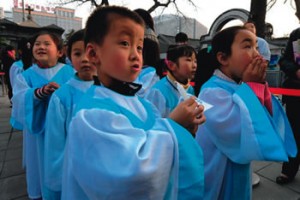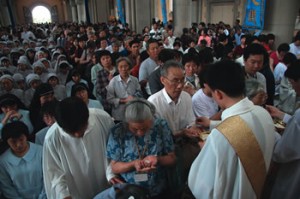The Catholic faith in mainland China
In the context of the year of Faith and my research work at the Holy Spirit Study Centre, I became interested in the way Chinese Catholics lived their faith.
Of course it is very hard to generalise, because China is so huge and the situations so different between the North and the South, between the villages and the cities, between official and clandestine communities, and those with or without a resident priest. After having questioned a sample of Catholics more or less representative of this diversity, I am suggesting some points to help better understand the faith of Catholics in China.
In traditionally Catholic families, basically in a rural environment, the faith is primarily family-based. The children are often baptised before the 8th day, and it is the parents who teach the prayers and the commandments to the young children. In the last twenty years, many young parents have left the villages to look for work in the cities or industrial centres, leaving the children in the village with their grandparents. So the handing-on of the faith is very dependent on the grandparents. The children learn to pray in the family situation, and take part in catechism camps at the time of the (Chinese) New Year holidays or during the summer. In most cases there is no catechism during the year, and, as well, the children rapidly become boarders. Because their Christian formation is often limited to prayers and bits of catechism learnt by heart, adolescents often have difficulty in integrating faith and life. They do not have the means they need to handle the contradictions between their faith and what they learn at school in a pro-active atheist system. The young people from rural areas soon leave school (few go to high school) to go and work elsewhere: the priority is to earn money, and there isn’t much room in their lives for the Church. Their faith is linked to the village and the community – they find it again when they return to the village.
Conversions and the motivations of converts
In the rural situation, the converts are essentially elderly people. Faced with the difficulties of life, poor health, problems of property, they turn to the Church to get God’s help. Some young adults ask for baptism along with marriage: Catholic families often demand that the non-catholic party be baptised before marriage; sometimes it is the contact with the Catholic family which motivates a desire for baptism. Many Catholics attract their parents or friends to the Church, but they leave to the priest or the nuns the task of instructing them. In the countryside, the catechumenate effectively does not exist, and often amounts to a quick instruction based on questions and answers from the Catechism. Admission to baptism (as for the other sacraments) is based mainly on the candidate’s ability to answer questions and to recite prayers, and very little on the level of personal relationship to Christ. Rural parishes organise intensive instruction sessions at the time when work in the fields becomes less demanding. The rural Chinese are still very open to traditional beliefs about life after death, supernatural forces, Heaven and Hell. They are baptised quickly, in the hope that they will continue to grow in their faith.
In the towns and cities the expectations are different. Faced with growing stresses created by work, family, education of children, health problems, politics, etc., many young or not so young people are looking for interior peace. More and more parishes are organising catechumenate classes, most led by a priest or a nun, and which last about three months, or even six months in the best cases. Certain priests are well-known and attract crowds, with record numbers of baptisms. But with too short a period of formation, most of the newly-baptised do not have the knowledge of Christian teaching, nor the engagement with God, nor the roots in the community which allow growth in faith, and many disappear soon after baptism (a problem not unknown in N.Z. – translator’s note).
Young people in the cities and migrants
If the 40 – 60 year-old age group, which grew up during the Cultural Revolution (1966 – 76) was very influenced by atheistic education, which presented religion as a superstition, the younger generations, particularly the students, are much more affected by globalisation and openness to Western values: they are easily attracted to get to know the Bible and Christianity. In the universities the young Catholics are often very active, and do not hesitate in encouraging their friends to follow Christ. In many university cities across China, the local church is developing programmes adapted to students, with good human and Christian formation, a good community and prayer life adapted to the young, and social justice work.
The challenge for these communities is to help the newly-baptised students to rise from a fashionable faith (it’s ‘with it’ to be Catholic) to a life committed to following Christ. If the pastoral care of the students is a priority for many dioceses, the pastoral care of the migrants is almost non-existent. In the midst of some 250 million migrant workers come to get work in the urban centres, there is a good number of young Catholics who are cut off from the church for several reasons: most frequently they live in the distant suburbs, far from churches (whose existence they do not know of), and they work seven days a week. Their only contacts with the Church are limited to the time when they go back to the village at the New Year. Several dioceses have begun to list migrant care among their pastoral priorities, but there are not many initiatives of this sort.
(To be continued)
(From “Missions etrangeres de Paris” No 485, July- August 2013, translated by Brian Quin, s.m.)



 Entries(RSS)
Entries(RSS)